Lately I’ve been having a lot of conversations around investment terms with searchers, as well as investors.
About 15 years ago, I interned at a search fund. And, over the last few years, I’ve started to invest in the asset class going direct as well as through funds of search funds.
Investing in search funds is a great way to scratch my entrepreneurial itch, extremely rewarding when a searcher finds success, and can be economically rewarding too.
This post is my attempt to share thoughts on self funded search economics in an effort to contribute to the search fund community, get feedback on my thinking from a wider audience, and of course meet more people who are doing searches/investing and may want to collaborate (please feel free to reach out!).
You can watch a video of me explaining this model here, and download the excel here:

Enterprise Value
The standard finance equation is enterprise value = debt + stock – cash. Enterprise value is how much the company itself is worth. Many times people confuse it with how much the stock is worth and find the “minus cash” part of this really confusing.
So, you can rearrange this equation to make it stock = enterprise value – debt + cash. Make more sense now?
Enterprise value is just how much you’re willing to pay for the company (future cash flows, intellectual property, etc), not the balance sheet (debt and cash).
Most investors and searchers think about the EBITDA multiple of a company on an enterprise value basis because they’ll be buying it on a cash free, debt free basis. It becomes second nature to think about EBITDA multiples and know where a given business should fall given scale, industry, etc.
However, I believe this second nature way of thinking of things can be a massive disadvantage to investors given the way EV and multiples are talked about in our community currently.
Sources of capital, the typical way to calculate enterprise value for self funded searchers
If you’ve ever looked at or put together a teaser for a self funded search deal, you will notice that the deal value is equal to the sum of the sources of capital minus deal fees and cash to the balance sheet.
As a simple example, if there is $4 mm of debt to fund the deal, $1 mm of equity, and $200k of deal fees, the enterprise value = $4 mm + $1 mm – 200k = $4.8 mm.
We’ll use slightly more complex numbers in our example: If a searcher is taking a $3.2 mm SBA loan, $850k seller note, putting in $120k themselves, getting $350k of equity from the seller, a $500k earnout, and $1.2 mm of equity financing minus $350k to the balance sheet and $250k of deal fees, then the enterprise value will be $5.62 mm.
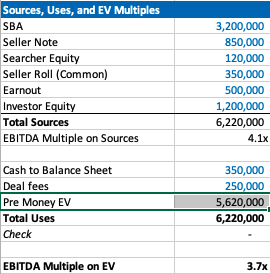
Our example company has $1.5 mm of EBITDA, so the EBITDA multiple is 3.7x. This is a pretty attractive acquisition multiple for a business that meets traditional search criteria (recurring revenues, fragmented competition, high gross margins, low customer concentration, etc).
If you’re seeing a search fund deal for the first time, the headline of “we’re buying a decent company for 3.7x, and replacing a tired owner with a hungry operator” is pretty exciting!
However, if you’re an investor, there is some nuance to this enterprise value number and the true EBITDA multiple you are investing in.
The trick with self funded enterprise value
The security that most self funded search investors get in a deal is participating preferred stock with a paid in kind dividend. This means when there’s an exit, you get your money back before any other equity holder, then get a certain percent of the business, and whatever dividend you’ve been owed in the interim accrues to your principle.
It’s a really favorable security for the investor, and one that is basically impossible to get in VC where straight preferred stock is much more common (no pun intended).
The key terms are what percent of common equity does this security convert into after the originally principal is paid back, and what is the dividend.
The share of common equity the investor group will get typically ranges from 10-50% of the total common stock. The dividend rate is usually 3-15%. The average I’m seeing now is around 30% and 10% for common and dividends respectively.
The strange this about the enterprise value quoted to investors in a teaser/CIM is that it doesn’t change as the percent of common changes, even though this has large implications for how much the common equity is worth and the value investors receive.
For example, I may get a teaser where the sources of investment – cash to balance sheet – deal fees = $3.7 mm for a $1 mm EBITDA company, which would imply a 3.7X EBITDA multiple. Let’s say the searcher is offering investors 30% of the common and a 10% dividend.
Let’s now say that the searcher is having a tough time raising capital and changes their terms to 35% of common and a 12% dividend. Does the effective enterprise value change for investors? I would argue yes, but I would be surprised to see it changed in the CIM/teaser.
This isn’t a knock on searchers or the search fund community. It’s just kind of how things are done, and I think this is mostly because it’s really hard to think about how the enterprise value has changed in this scenario.
However, the natural way of using EBITDA multiples to think about value for a business that is so common in PE/SMB can be extremely misleading for investors here. You may be thinking 3.7X for this type of business is a great deal! But, what if the security you’re buying gets 5% of the common?
If you’re in our world, you may counter this point by saying most searchers will also supply a projected IRR for investors in their CIM. However, IRR is extremely sensitive to growth rate, margin expansion, and terminal value. While the attractiveness of the security will be reflected, it can be greatly overshadowed by lofty expectations.
To get more clarity and have a slightly different mental model on the effective price investors are paying for this business, let’s go back to basics. Enterprise value should be debt + preferred stock + common stock – cash.
We know the values of each of these numbers, except the common. So, the main question here becomes: how much is the common equity worth?
Calculating value of common equity for self funded search funds
Equity value for most search fund deals = preferred equity from investors + the common equity set aside for the searcher and sometimes also advisors, board, seller.
We know that the preferred equity is investing a certain amount for a certain amount of common equity. The rub is that they are also getting a preference that they can take out before any common equity gets proceeds, and they are getting a dividend.
So, the exercise of valuing the common equity comes down to valuing the preference and dividend.
In my mind, there are three approaches:
- The discount rate method where you take the cash flows you’ll get in the future from the pref/dividends and discount them back at the discount rate of your choice. I am using 30% in my model which I believe accurately compensates investors for the risks they are taking in a small, highly leveraged investment run by an unproven operator. If you believe in efficient markets, this number also fits as it mirrors the historical equity returns as reported by the Stanford report, with a slight discount given this asset class has clearly generated excess returns relative to other assets on a risk adjusted basis, hence interest in these opportunities from an expanding universe of investors.
- The second method is to calculate how much money you’d get from your preference and dividends, taking into account that per the Stanford study around 75% of search funds will be able to pay these sums, and then discount these cash flows back at a rate more in line with public equities (7% in my model). This yields a much higher value to the preference/dividend combo, and therefore lowers the implied value of the common equity.
- The last method is to just say nope, there is no value to the preference and dividend. I need them and require them as an investor, but they are a deal breaker for me if they aren’t there, and therefore they don’t exist in my math. This of course makes no logical sense (you need them, but they also have no value?), but I’ve left it in as I think many investors probably actually think this way and it creates a nice upper bound on the enterprise value. Side note, as with obstinate sellers, jerk investors are usually best avoided.
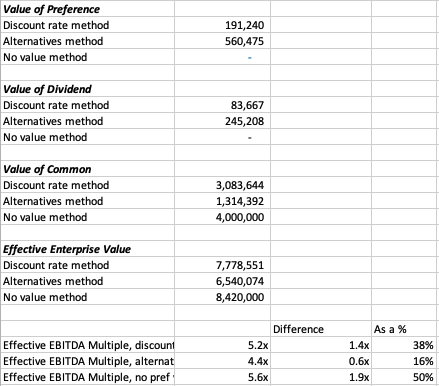
In our example, you can see a breakdown of the preference value, dividend value, and therefore common value and enterprise value for this deal.
In each case, the effective EBITDA multiple moves from 3.7x to something much higher (see the last 3 lines).
There are some simplifying assumptions in the model (no accruing dividend, all paid in last year), and some weird stuff that can happen (if you make the hold time long and the dividend greater than the 7% equity discount rate, the value of the dividend can get really big).
These flaws aside, I think this creates a nice framework to think through what the common is actually worth at close, and therefore what enterprise value investors will be paying in actuality.
It’s worth noting that the whole point of this is to benchmark the value you’re getting relative to market transactions in order to understand where you want to deploy your capital.
This creates a method to translate cash flow or EBITDA multiples of other opportunities on an apples to apples basis (if only there were a magical way to translate the risk associated with each as well!).
Another note, we could calculate the value of the common to be what this asset would trade at market today in a well run auction process minus any obligations (debt, preference, seller financing). However, I think that understates the option value inherent in this equity, a value that is only realized when a new manager takes over with more energy and know how.
There is a finance nerd rational for this. If you plot the value of equity in a leveraged company on a chart, it mirrors the payout of a call option. In both cases, the value of the security increases at a certain inflection point: when the value of equity rises above the strike price in an option, and when the enterprise value of a company rises above the debt level in a levered company.
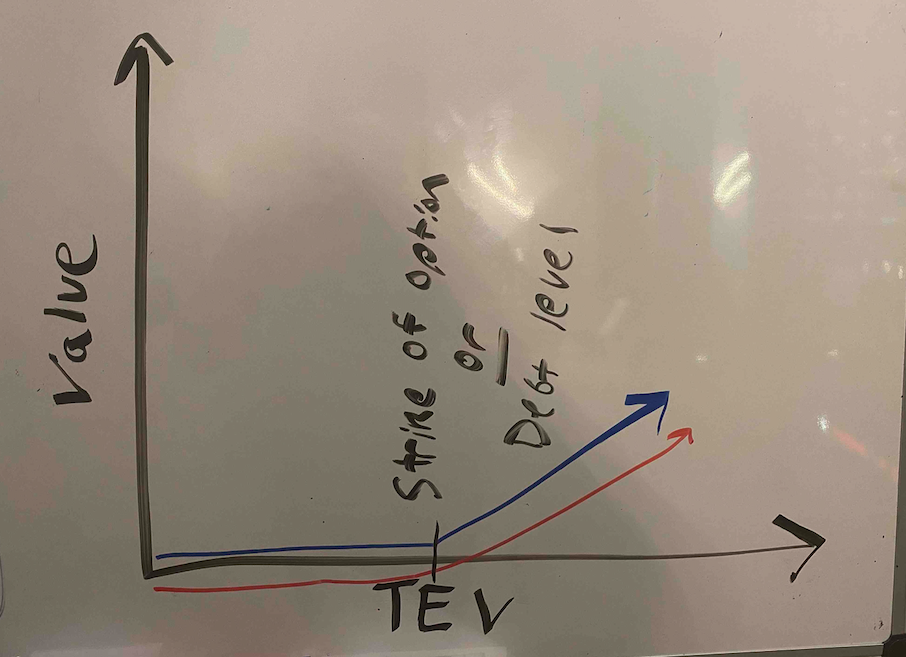
The common equity of a highly levered company can therefore be valued by a similar methodology as the call option: Black Scholes. If you remember back to finance class, increasing volatility will increase the value of an option.
In the search fund case, we’ve (hopefully) increased the (upside) volatility and therefore create more value than simply selling the company today.
A few more thoughts on investor economics
There are a few other ways to think about the economics you get as an investor to best understand if this is the deal for you.
First, you may want to think about how much your investment will be worth day 1. The key lever in this model is what discount this company is being bought for relative to fair market value. For example, the searcher may have proprietary sourced a great company and is buying it for 25% below what it would trade at in a brokered auction.
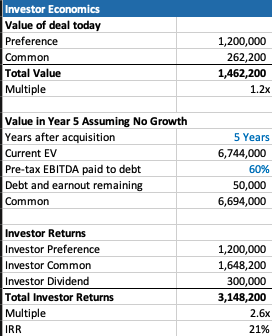
This is very much a “margin of safety” philosophy on things. Same with the calculation on how much you’ll receive in year 5 (after QSBS hits) assuming no growth in the business.
The only problem with each of these calculations is that they never play out in practice. Most companies don’t just stay the same, you’re either in a rising tide or you’re in trouble. And, you’re almost never going to sell in year 1, and definitely not for a slight premium to what it was bought for.
However, if your investment is worth 30% higher day one, and you can make a 20% IRR assuming nothing too crazy happens either way in the business, that’s not a bad place to start. Add in a strong searcher, decent market, some luck, and you’re off to the races.
Thoughts on searcher economics
A lot of this post has considered things from the investor perspective as my main quandary was related to how to create an EBITDA multiple that made sense for investors.
However, the point of this post is not to say searchers are misrepresenting or being unrealistic with their terms. In fact, I think it’s quite logical that self funded searchers capture the massive economic value that they do.
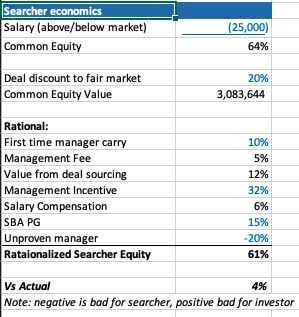
There are many reasons why self funded searchers deserve the lion share of the common equity.
First, they are providing a nice service of giving investors a positive expected value home to park their money with much lower correlation to the market than other asset classes ($1 mm EBITDA companies don’t see lots of multiple contraction/expansion throughout cycles).
Most money managers that fit that criteria are taking a 2/20, of course they also usually have a track record. So, I’ve used a 10% carry in my model, but stuck to 2% annual management fee.
The searcher spent a lot of time, and probably money, finding this company. That’s a lot of value, especially if it’s a below market price. They should be able to capture a lot of the value in finding a below market deal.
The searcher may be taking a below market salary, and needs to get comped like any CEO, with stock options. In my example model I have $1 mm of stock vesting over the hold period, as well as extra comp for taking a below market salary.
Searchers are also usually putting their financial standing at risk by taking a personal guarantee on the bank/SBA loan. This is really tough to put a number on, as is the last line in my framework where searchers are dinged for lack of experience. Like any good model, you need a few lines that you can fudge to make the math work 🙂
What you do think?
I’m shocked that I wrote all this. I was going to type a few paragraphs and a quick excel. However, putting this to paper has been a great exercise for me to sharpen my thinking.
Now I’d like you to help me further. Where do you think this should be changed in this framework? How do you think about things from the investor and/or searcher side?
Feel free to shoot me a note if you have thoughts (even just to tell me I’m being way too academic with this, which I actually agree with).
Lastly, a post like this is really a trap I’m putting on the internet to catch any like minded people in so that we can figure out ways to collaborate now or in the future. So, at the very least, connect with me on LinkedIn 🙂

Wow, wonderful blog layout! How long have you been blogging
for? you made blogging look easy. The overall
look of your website is magnificent, as well as the content!
Fantastic beat ! I would like to apprentice while you amend your web site, how
could i subscribe for a blog website? The account helped me a
acceptable deal. I had been tiny bit acquainted of this
your broadcast offered bright clear idea
Wonderful, what a website it is! This webpage presents helpful information to us, keep it up.
Actually no matter if someone doesn’t understand
after that its up to other users that they will assist, so here it
happens.
Hi, I do believe this is an excellent blog.
I stumbledupon it 😉 I’m going to revisit once again since i have book-marked it.
Money and freedom is the greatest way to change,
may you be rich and continue to guide others.
I just couldn’t depart your website prior to suggesting that I really enjoyed the usual information a person provide for your visitors?
Is going to be again ceaselessly to investigate cross-check new posts
Its not my first time to pay a quick visit this web site, i am visiting this web page dailly and obtain fastidious facts from here all the
time.
Great post. I was checking continuously this blog and I am impressed!
Very useful information specifically the last part 🙂 I care for such info a lot.
I was seeking this particular info for a very long
time. Thank you and good luck.
I have read several just right stuff here. Definitely value bookmarking for revisiting.
I wonder how a lot attempt you set to create this
kind of fantastic informative web site.
Pretty nice post. I just stumbled upon your weblog and wanted to
say that I have truly enjoyed surfing around your blog posts.
In any case I’ll be subscribing to your rss feed and I hope you
write again soon!
Hello to every body, it’s my first pay a visit of
this webpage; this webpage includes amazing and truly
excellent material in favor of readers.
I am genuinely happy to glance at this website posts which includes lots of useful information, thanks for providing these kinds of information.
Everyone loves it when folks get together
and share opinions. Great blog, continue the good work!
Look into my blog post: agen poker deposit pulsa
you are actually a excellent webmaster. The site loading pace is incredible.
It seems that you are doing any unique trick. Furthermore, The contents are masterpiece.
you’ve done a fantastic job on this matter!
Great post. I used to be checking constantly this blog and I am
impressed! Very helpful information specially the ultimate part 🙂 I care for such info a lot.
I used to be seeking this particular information for a long time.
Thanks and best of luck.
I’m amazed, I have to admit. Seldom do I come across a blog that’s both
educative and engaging, and let me tell you, you’ve hit the
nail on the head. The problem is something which not
enough folks are speaking intelligently about.
I’m very happy I came across this during my search for something regarding this.
I am sure this piece of writing has touched all
the internet viewers, its really really good piece of writing
on building up new blog.
bookmarked!!, I like your web site!
I think this is one of the most vital info for me. And i am glad
reading your article. But wanna remark on some general things, The web site style is ideal, the articles is really excellent :
D. Good job, cheers
It’s an remarkable article in support of all the internet people; they will obtain advantage from it I am sure.
I was able to find good info from your blog posts.
An intriguing discussion is worth comment. I do think that you should publish more on this issue,
it might not be a taboo matter but generally folks don’t talk about these subjects.
To the next! All the best!!
Greetings! I know this is kind of off topic but I was
wondering if you knew where I could find a captcha plugin for my comment form?
I’m using the same blog platform as yours and I’m having trouble
finding one? Thanks a lot!
Hello there! Do you know if they make any plugins to assist
with SEO? I’m trying to get my blog to rank for some targeted keywords but
I’m not seeing very good success. If you know of any please share.
Appreciate it!
Hello to all, for the reason that I am truly eager of reading this weblog’s post to be updated
on a regular basis. It contains nice material.
I am really enjoying the theme/design of your web site.
Do you ever run into any internet browser compatibility issues?
A couple of my blog readers have complained about my blog not working correctly in Explorer but looks great in Chrome.
Do you have any ideas to help fix this issue?
Hello to every body, it’s my first pay a visit of
this blog; this website contains amazing and genuinely fine data in support
of readers.
I quite like reading an article that can make men and women think.
Also, thank you for allowing me to comment!
Your way of describing everything in this post is in fact nice, all be capable of simply
know it, Thanks a lot.
certainly like your web site but you have to test the spelling on several of your posts.
A number of them are rife with spelling problems and I to find it very
bothersome to inform the reality however I will definitely come back again.
First of all I would like to say terrific blog! I had a quick question which I’d
like to ask if you don’t mind. I was interested to
know how you center yourself and clear your mind before writing.
I’ve had a difficult time clearing my mind in getting my
thoughts out there. I do enjoy writing however it
just seems like the first 10 to 15 minutes are usually
wasted just trying to figure out how to begin. Any ideas or hints?
Kudos!
I seriously love your blog.. Excellent colors & theme. Did you
make this amazing site yourself? Please reply back as I’m trying to create my very
own site and would love to learn where you got this from or exactly what the theme is called.
Kudos!
Feel free to surf to my blog post poker deposit pulsa tanpa potongan
I do not know whether it’s just me or if perhaps everybody else experiencing problems with your blog.
It seems like some of the text within your posts are running off
the screen. Can someone else please comment and let me know if this is happening to
them too? This might be a problem with my internet browser because I’ve had this happen previously.
Thank you
Way cool! Some very valid points! I appreciate you writing this write-up and also the
rest of the site is also very good.
Pretty! This was an incredibly wonderful article. Thank
you for providing this info.
This website was… how do I say it? Relevant!! Finally I’ve found something which helped me.
Many thanks!
I loved as much as you will receive carried out right here.
The sketch is attractive, your authored subject matter stylish.
nonetheless, you command get bought an shakiness over that you wish be
delivering the following. unwell unquestionably come further formerly again since exactly
the same nearly very often inside case you shield this increase.
Hello! I know this is kinda off topic but I was
wondering which blog platform are you using for this website?
I’m getting tired of WordPress because I’ve had issues with hackers and I’m looking at alternatives for another platform.
I would be awesome if you could point me in the direction of a good platform.
Hello to every single one, it’s really a fastidious for me to
visit this web site, it includes helpful Information.
Hello there! I could have sworn I’ve been to this blog before but
after reading through some of the post I realized it’s new to
me. Anyways, I’m definitely glad I found it and I’ll be book-marking and checking
back often!
Hi my loved one! I want to say that this post is awesome, nice written and include almost all vital infos.
I would like to look extra posts like this .
Howdy! I just wish to give you a big thumbs up for your great information you have
got here on this post. I will be coming back to your website for more
soon.
Good post. I learn something new and challenging on sites I stumbleupon every
day. It’s always exciting to read through content from other writers
and use something from their sites.
It’s actually a nice and useful piece of info.
I’m satisfied that you just shared this useful information with us.
Please keep us up to date like this. Thank you for
sharing.
I visited multiple web pages except the audio quality for audio songs current at this site is genuinely
wonderful.
Howdy! This post couldn’t be written any better! Reading through this post reminds me
of my previous roommate! He constantly kept preaching about this.
I am going to send this post to him. Pretty sure he’s going to have a great read.
Many thanks for sharing!
Hi there would you mind stating which blog platform
you’re working with? I’m going to start my own blog
soon but I’m having a tough time making a decision between BlogEngine/Wordpress/B2evolution and Drupal.
The reason I ask is because your layout seems different
then most blogs and I’m looking for something completely unique.
P.S Apologies for getting off-topic but I had to ask!
my page; ayamindo.com
After looking over a handful of the articles on your site,
I seriously appreciate your technique of writing a blog.
I book marked it to my bookmark site list
and will be checking back in the near future. Please check out my website as
well and let me know your opinion.
Greetings from Colorado! I’m bored to death at
work so I decided to browse your site on my iphone during lunch break.
I enjoy the information you present here and can’t wait to take
a look when I get home. I’m amazed at how quick your blog loaded on my cell phone
.. I’m not even using WIFI, just 3G .. Anyways, excellent blog!
Wonderful article! This is the type of information that are
supposed to be shared around the internet. Shame on the seek engines for not positioning this post upper!
Come on over and talk over with my site . Thanks =)